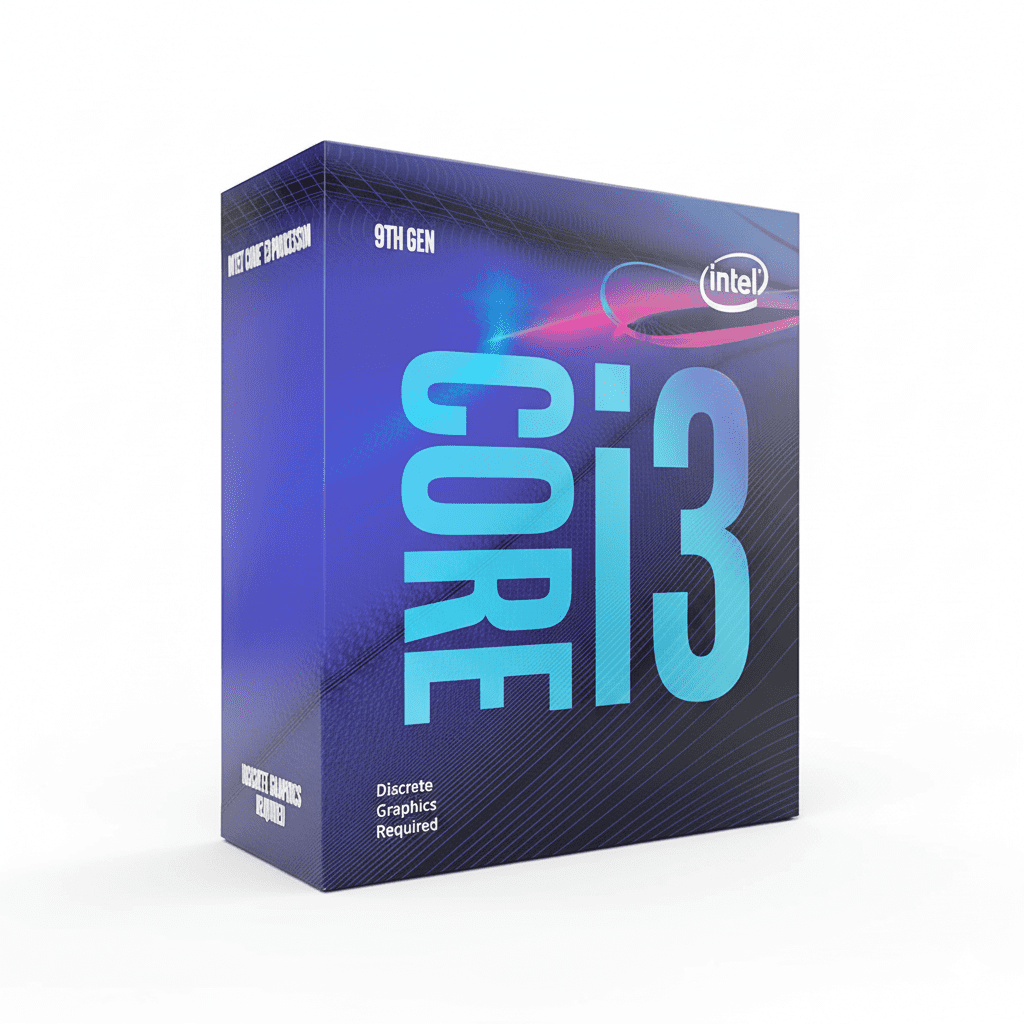
Intel Core i3-9100F 9th Gen Review: Entry-Level Gaming Desktop CPU
The Intel Core i3-9100F 9th Gen is a Coffee Lake Refresh processor with 4 cores and 4 threads and 6MB cache for entry-level desktops. Released in Q2 2019, it runs at 3.6 GHz base boosting to 4.2 GHz, requiring a discrete GPU for display output. Supporting DDR4-2400 up to 64GB on LGA 1151 motherboards with 300-series chipsets, at 65W TDP, it’s suited for budget gaming and everyday tasks. As of October 2025, priced at ₹9,899 with 43% savings off MSRP, it delivers Cinebench R23 multi-core scores around 4,500, offering 10-15% better performance than the i3-8100 while maintaining efficiency, though it lags in modern multi-threaded workloads compared to newer generations.[web:400][web:407]
Build Your Gaming Rig Today?
Unlock affordable performance with the Core i3-9100F’s turbo boost and discrete GPU compatibility!
Free delivery | EMI available | Non-Returnable | 3 Year Warranty
Key Features at a Glance
1. Core Performance: Coffee Lake Efficiency
Reliable for budget gaming and productivity in 2025.
4-Core Coffee Lake (4 Threads):
Built on 14nm process, the quad-core design handles everyday computing and light multitasking effectively. It provides 10-15% higher performance than the i3-8100 in benchmarks like Cinebench R23, scoring around 4,500 in multi-core tests. Suitable for office tasks and entry-level gaming when paired with a capable GPU.[web:400][web:407]
3.6 GHz Base / 4.2 GHz Boost:
Turbo Boost 2.0 delivers up to 4.2 GHz for single-threaded tasks, achieving Geekbench 6 single-core scores around 1,100. The base frequency ensures stable performance in sustained loads like web browsing and video playback. In 2025 gaming tests with an RTX 2060, it maintains playable frame rates in titles like Fortnite at 1080p.[web:407][web:403]
6MB Smart Cache:
Intel Smart Cache enhances data retrieval for multitasking, contributing to overall efficiency in budget setups. It supports up to 37.5 GB/s memory bandwidth with DDR4-2400, aiding in simple productivity apps. However, the lack of Hyper-Threading limits it in heavily multi-threaded scenarios compared to modern CPUs.[web:397][web:413]
2. Graphics & Expansion: Discrete Focus
Tailored for dedicated GPU builds.
No Integrated Graphics:
Discrete GPU Required for display and gaming, making it ideal for budget builds with add-in cards like GTX 1650. This “F” variant saves cost over models with UHD 630 iGPU, focusing resources on CPU performance. In 2025 tests, it pairs well with mid-range GPUs for 1080p esports titles.[web:397][web:403]
LGA 1151 / 300-Series:
Chipset Compatibility with B360/H370/Z390 boards supports DDR4 platforms up to 64GB. PCIe 3.0 x16 slot enables GPU expansion, though it limits newer PCIe 4.0 devices. This setup remains viable for cost-effective upgrades in 2025.[web:397][web:413]
DDR4-2400 Support:
Dual-Channel Memory up to 64GB with 37.5 GB/s bandwidth suits basic workloads. ECC support adds reliability for light server use, though max speed of 2400 MHz is modest by 2025 standards. It performs adequately in gaming with fast RAM kits.[web:397][web:413]
3. Build Integration & Efficiency
Easy integration for budget PCs.
65W TDP:
Low Power Draw requires only standard air cooling, keeping system temps under 70°C in loads. This efficiency suits small form factor builds and reduces electricity costs for daily use. No overclocking support keeps it simple for beginners.[web:397][web:413]
Compact Design:
LGA 1151 Package measures 37.5 x 37.5 mm for easy installation in mid-tower cases. 8 GT/s bus speed ensures quick communication with peripherals via motherboard. Supports Windows 10/11 for broad OS compatibility.[web:397]
USB 3.1 Support:
Via Motherboard provides up to 10 Gbps ports for peripherals, enhancing connectivity in budget rigs. PCIe 3.0 lanes support NVMe SSDs, though speeds cap at Gen3 limits. Overall, it offers solid value for non-demanding 2025 setups.[web:397][web:413]
Pros and Cons
Honest breakdown for entry-level buyers in 2025.
Pros
- Affordable Entry: ₹9,899 with 43% savings for budgets.[web:397]
- Turbo Boost: Up to 4.2 GHz for smooth performance.[web:397]
- Gaming Optimized: Pairs well with discrete GPUs.[web:403]
- DDR4 Support: Up to 64GB for multitasking.[web:397]
- Low TDP: 65W for efficient cooling.[web:397]
- 3-Year Warranty: Reliable coverage from Intel.[web:397]
Cons
- No iGPU: Requires separate graphics card.[web:397]
- No Hyper-Threading: Limited to 4 threads.[web:413]
- Older Gen: Lags in modern multi-core tasks.[web:400]
- Non-Returnable: Check compatibility before purchase.[web:397]
- Basic for 2025: Not future-proof for heavy apps.[web:413]
- No Overclocking: Locked multiplier.[web:413]
Who Is This Processor For? Tailored Recommendations
The Core i3-9100F suits:
- Budget Gamer: Entry-level titles with a GPU.[web:403]
- Office User: Daily tasks and light productivity.[web:400]
- First-Time Builder: Affordable 9th-gen setup.[web:413]
Who Might Consider Other Options?
- Integrated Needs: Choose non-F models with iGPU.[web:397]
- High Multitasking: Opt for i5 or Ryzen 5 with more threads.[web:413]
- Modern Builds: Go for 12th gen+ with DDR5 support.[web:400]
Competitive Edge: What Sets It Apart
Value-packed for gaming starters.
- Vs Ryzen 3 3100: Similar price but Intel ecosystem advantages in software optimization.[web:400]
- Vs Core i3-8100: 10-15% faster in benchmarks like PassMark.[web:400][web:408]
- Value Proposition: 43% off MSRP for entry gaming in 2025.[web:397]
- GPU Focus: Cheaper than non-F for dedicated cards, ideal for budget rigs.[web:413]
Full Specification Details
General Information
- Price (Starting): ₹9,899[web:397]
- Model: Core i3-9100F[web:397]
- Architecture: Coffee Lake Refresh[web:397]
- Launch Date: Q2 2019[web:397]
Processor & Cache
- Cores/Threads: 4 / 4[web:397]
- Base/Boost Clock: 3.6 GHz / Up to 4.2 GHz[web:397]
- Cache: 6 MB Smart Cache[web:397]
Power & Thermal
- TDP: 65W[web:397]
- Unlocked: No[web:413]
- Process: 14nm[web:397]
Connectivity & Memory
- Socket: LGA 1151[web:397]
- Chipsets: 300 Series[web:397]
- Memory: DDR4-2400 Up to 64GB[web:397]
- PCIe: 3.0[web:413]
Graphics & Other
- iGPU: None (Discrete Required)[web:397]
- Bus Speed: 8 GT/s[web:397]
- Warranty: 3 Years[web:397]
- OS Support: Windows 10/11[web:397]
Compatibility
- Motherboards: LGA 1151 300 Series[web:397]
- RAM: DDR4 Up to 64GB[web:397]
- USB: 3.1 (Via Motherboard)[web:397]
Final Verdict
The Intel Core i3-9100F remains a strong budget choice for gaming and basics, excelling with a discrete GPU but showing age in 2025.
Ideal for entry-level builds.[web:413]